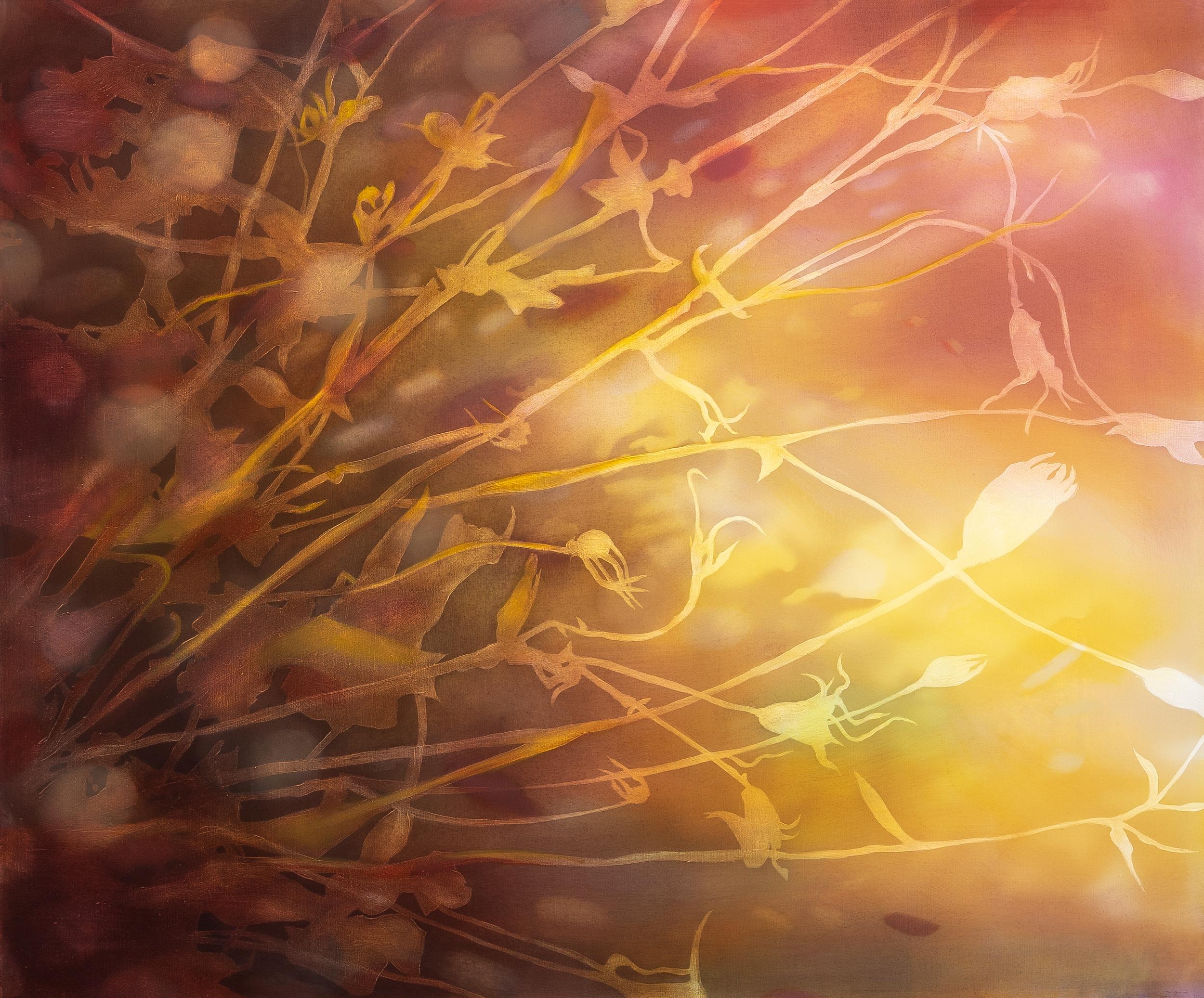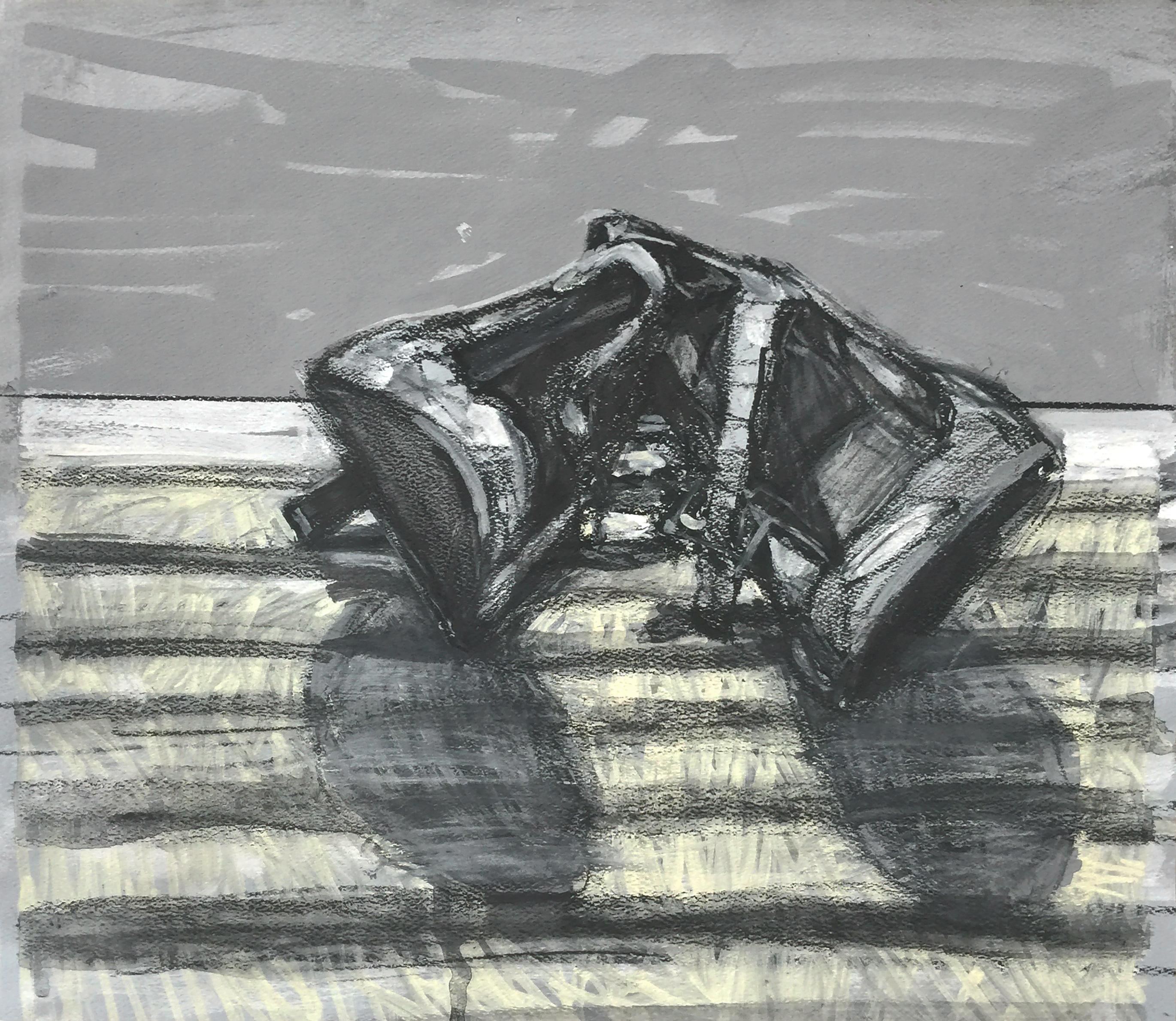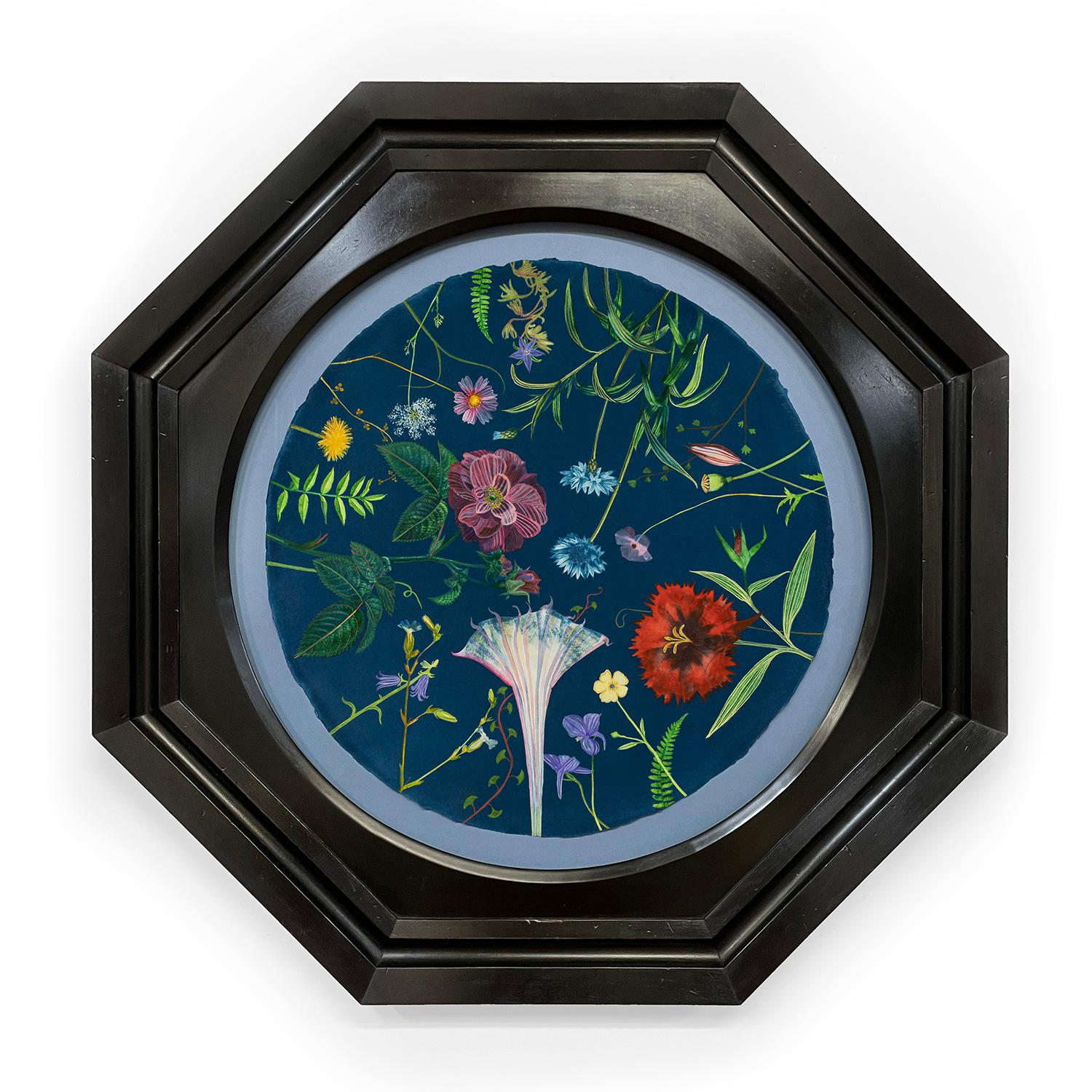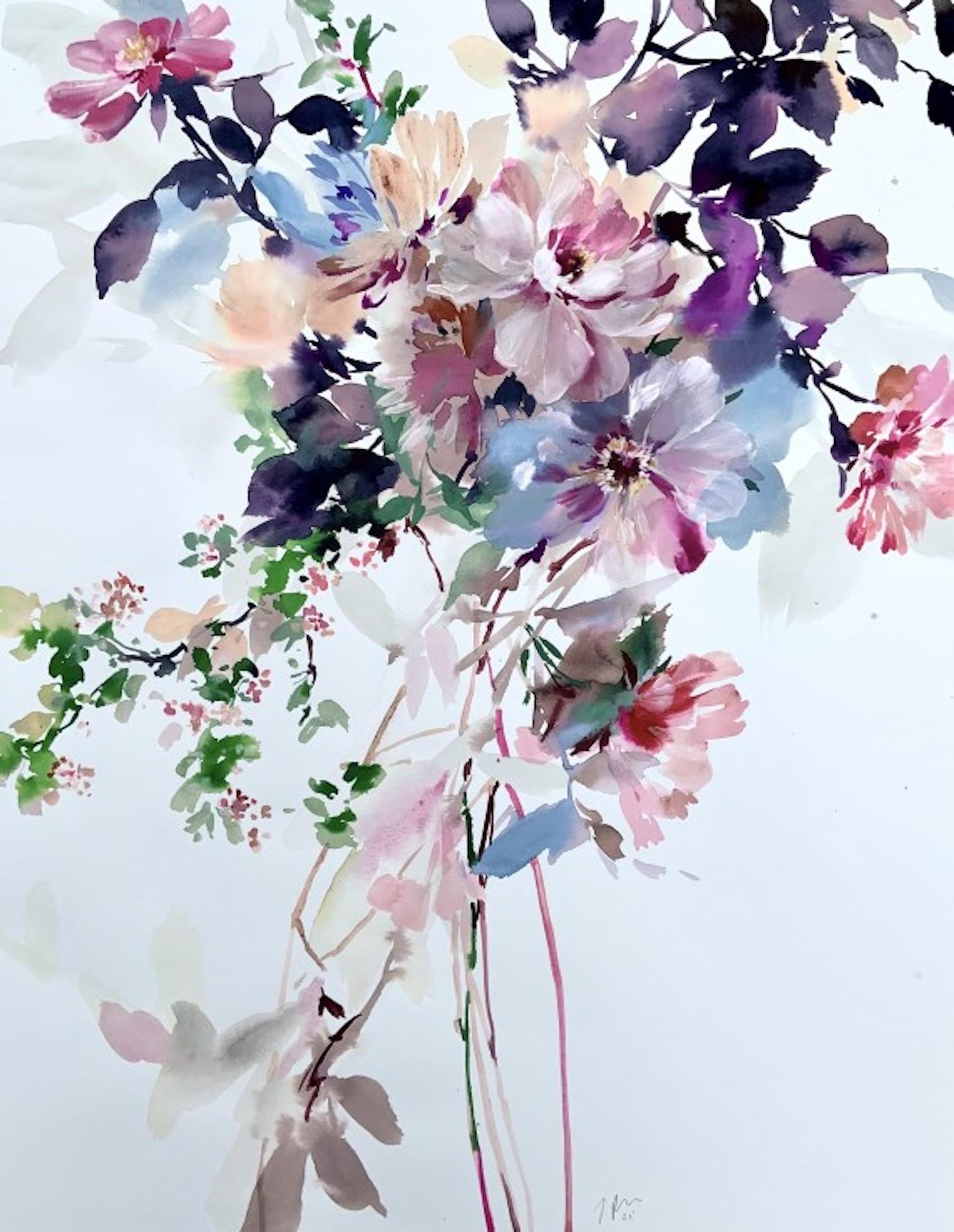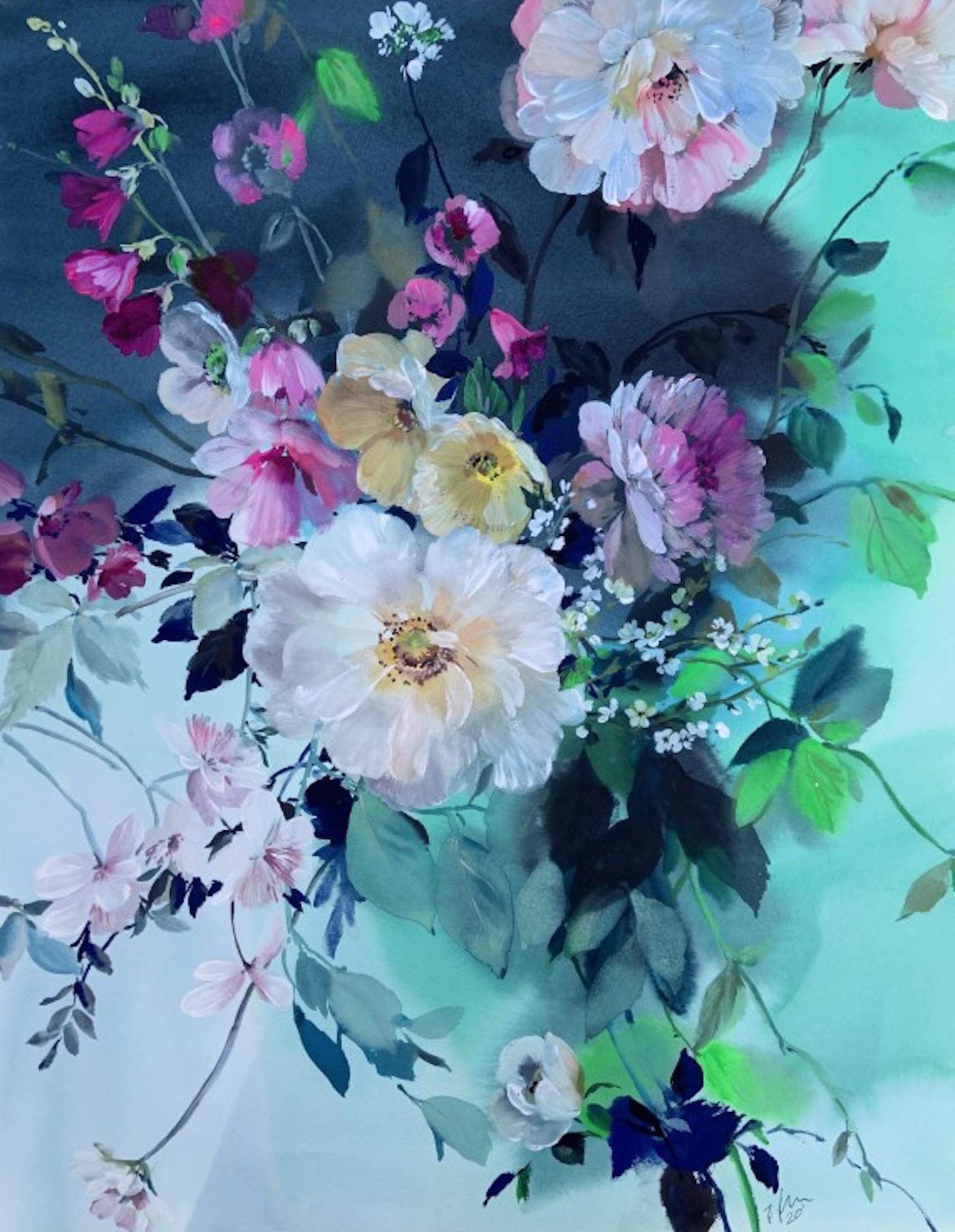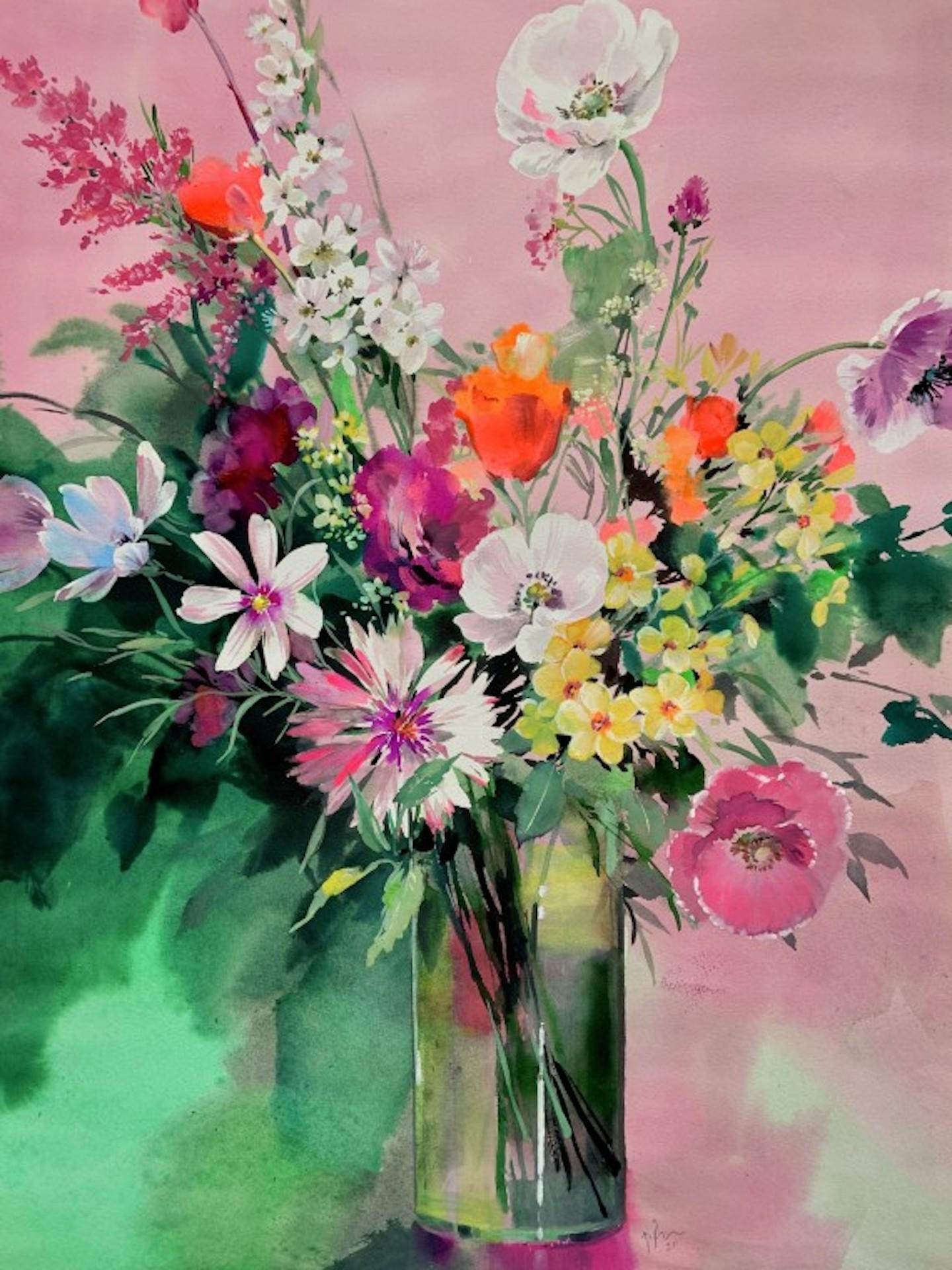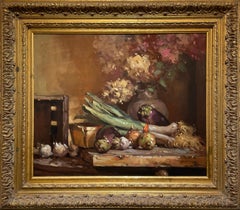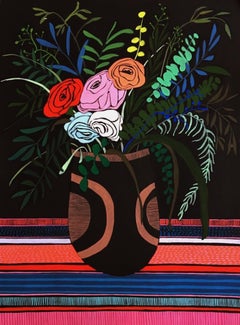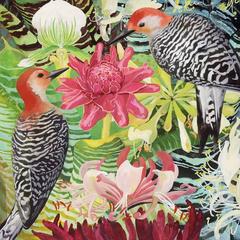
Awakening
View Similar Items
Want more images or videos?
Request additional images or videos from the seller
1 of 8
Laurie FlahertyAwakening2016
2016
About the Item
- Creator:Laurie Flaherty (1966, American)
- Creation Year:2016
- Dimensions:Height: 15 in (38.1 cm)Width: 12 in (30.48 cm)Depth: 1.7 in (4.32 cm)
- Medium:
- Movement & Style:
- Period:
- Condition:Painting framed in white shadow box frame. 21 x 21 framed.
- Gallery Location:Westport, CT
- Reference Number:Seller: LF0291stDibs: LU5441888593
About the Seller
5.0
Vetted Seller
These experienced sellers undergo a comprehensive evaluation by our team of in-house experts.
Established in 2009
1stDibs seller since 2014
379 sales on 1stDibs
More From This SellerView All
- "Hydrangeas on the Table, " Still Life Oil PaintingBy John C. TraynorLocated in Westport, CTThis impressionistic still life painting by Jon Traynor captures a wooden table top surface with an assortment of root vegetables and a porcelain vase filled with a bouquet of flowers. The painting overall features a warm, earthy palette which gives the sense of a warm glow being cast over the scene. The painting itself is 20" x 24" and 28" x 32" framed. It is professionally framed in an antiqued gold-hued frame. It is signed by the artist in the lower right-hand corner, and is wired and ready to hang. John C. Traynor's painting style is reminiscent of some 19th century painters and the Dutch Masters. He uses his knowledge of light and color to create a certain mood in each of his works. The creation of atmosphere is an important element in Traynor's paintings. Painting outdoors, on location, is a prime source of inspiration and ideas for his landscapes. John travels extensively, painting the landscapes around him. John was born in 1961 and spent his early years in Chester and Mendham, New Jersey. His art studies began at Delbarton School in Morristown, New Jersey, and from there he furthered his education at Paier College of Art in New Haven, Connecticut. He studied figure painting at the Art Students League of New York, as a merit scholar, with Frank Mason. Traynor continued his studies in Vermont with Mr. Mason on landscape painting, drawing with Carroll N. Jones Jr. of Stowe, Vermont and sculpture with Brother Jerome Cox...Category
1980s Impressionist Still-life Paintings
MaterialsCanvas, Oil
- "Lilacs, " Still-Life Oil PaintingBy John C. TraynorLocated in Westport, CTThis still life oil painting by John Traynor captures a scene of a large bouquet of purple and pink lilacs in a colorful, porcelain vase. It sits on an off-white fabric next to a lemon which is half peeled, the peel spiraling off the edge of the table on which it sits. The wall behind the bouquet of flowers is a warm, earthy sienna. The painting is signed by the artist along the lower right-hand edge of the canvas. It is 20" x 24", and 27" x 31" framed. The frame is an ornate metal-leaf frame with a linen liner. It is wired and ready to hang. Professionally framed in classic, antiqued, closed corner frame. Frame is metal leaf gold. John C. Traynor's painting style is reminiscent of some 19th century painters and the Dutch Masters. He uses his knowledge of light and color to create a certain mood in each of his works. The creation of atmosphere is an important element in Traynor's paintings. Painting outdoors, on location, is a prime source of inspiration and ideas for his landscapes. John travels extensively, painting the landscapes around him. John was born in 1961 and spent his early years in Chester and Mendham, New Jersey. His art studies began at Delbarton School in Morristown, New Jersey, and from there he furthered his education at Paier College of Art in New Haven, Connecticut. He studied figure painting at the Art Students League of New York, as a merit scholar, with Frank Mason. Traynor continued his studies in Vermont with Mr. Mason on landscape painting, drawing with Carroll N. Jones Jr. of Stowe, Vermont and sculpture with Brother Jerome Cox...Category
21st Century and Contemporary American Impressionist Still-life Paintings
MaterialsCanvas, Oil
- "Flight, " 1960s Modern Abstract PaintingBy Stanley BateLocated in Westport, CTThis Modern Abstract Expressionist painting by Stanley Bate is made with gouache on paper. It features a muted palette and large, textured brush strokes. The painting itself is 13" x 22" and it measures 21.25" x 29.25" x 1" framed. It is signed by the artist in the lower right-hand corner of the painting, and is framed in a black frame with an acid-free mat. Wired and ready to hang. Stanley Bate was born on March 26, 1903 in Nashville, Tennessee. The Bates were an established Tennessee family, in fact, Henry’s brother William Bate was the governor of Tennessee from 1883-1887 and a United States Senator from 1887-1905. Stanley studied art at the Watkins Institute in Nashville. In the 1920’s Bate moved to New York City to study at the Art Students League under Frederick Bridgman. He soon landed a job with Encyclopedia Britannica, and from 1927-1929 served as art editor. From 1929 until his death in 1972, Stanley was a self-employed artist. He taught art classes at both the Art Students League and the Albany Institute of History and Art and brought in extra income by making illustrations for magazines such as “Outdoor Life” and “Popular Science”. On January 27, 1934 Stanley married Emilie Rossel. Emilie had emigrated from Switzerland to New York in 1923. She found work as a governess to Alfred Vanderbilt and later as an executive secretary for Wall Street investment brokers Kahn, Loeb and Co. Emilie met Stanley in New York in the early 1930’s when she attended one of his art exhibitions with a friend. The couple, who had no children, lived on 34th Street in Manhattan. During this period, Bate was producing and exhibiting his art and joined several artists groups. Stanley and Emilie became part of the New York art scene, dining weekly at the Society of Illustrators Clubhouse. Stanley Bate’s time in New York was pivotal in the formation of his painting style. He lived in New York during the inception of one of the most important Modern Art movements, one that helped New York replace Paris as the center of avant-garde art. This movement, which was called the New York School of artists, was later known as Abstract Expressionism. It was comprised of a loosely associated group of vanguard artists working in New York City during the 1940s and 1950s. The New York School was not defined by a specific style, but instead reflected a fusion of European Modernism and American social relevancy that was depicted in many individual styles. Influences of Surrealism, Cubism, and Modernism can be found in their work, along with an interest in experimenting with non-traditional materials and methods. American art was in the forefront of international avant-garde for the first time. Stanley Bate was undoubtedly exposed to the varied styles and techniques that were emerging during the formative years of the New York School. Mark Rothko and Robert Motherwell were formulating their versions of color field paintings. Joseph Cornell was experimenting with assemblages, collage and the use of different types of textured paints. Jackson Pollock was adhering objects such as buttons and coins into his early works, while Louise Nevelson was using found objects. Helen Frankenthaler added sand to her early paintings. The New York School artists were undermining traditional fine art by using mixed media and non-traditional methods. Stanley Bate absorbed these varied influences and soon his early realistic landscapes and still-lifes were replaced with something entirely new. The influence of Cubism, notably the flat shallow space of the picture plane, is obvious in many of Bate’s paintings. Surrealism is evident in Bate’s use of subjects from myth, primitive art and antiquity, along with the Automatism-like line work in his more linear images. The unfettered experimentation of the New York School is everywhere in Stanley Bate’s work. We see nods to color field, collage, the mixing of textures into paint, mixed media, the inclusion of found objects and thick, luscious impasto. Bate was prolific and experimented in various media including oil, watercolor, lithography, silk screen, wood cut, drawing, collage, ceramics and sculpture. Bate is considered a true Modernist. His work is largely abstract, but sometimes figures and buildings are discernable. He frequently mixed paint, sand and glue together to achieve a textured surface, and then scraped and scratched through this layer to expose some of the underpainting below. His sculpture, which is often whimsical, also reflects the non-traditional methods of the New York School. Bate pioneered the use of enamel and copper in his work. The sculptures are not carved or modeled as was done in the past, but instead are built using mixed media and new materials. In addition to the New York School influence, many of Bate’s works exhibit a strong connection to the Spanish school, especially the work of Antonio Tapies and Modesto Cuixart. These artists were both part of an avant-garde group known as Art Informel, the Spanish equivalent of Abstract Expressionism. These artists likewise worked in mixed media and introduced objects and texture into their work. Many of Bate’s subjects and titles relate to Spanish locations and words. It is likely that Stanley spent time in Spain and found inspiration there. By the early 1940s, Stanley and Emilie had started spending weekends in a barn they purchased in Craryville, New York, a few hours north of Manhattan. The barn had no electricity or plumbing, but when the Bates eventually decided to leave New York and live full time in Craryville, they remodeled the barn, putting a gallery downstairs and a studio and living quarters upstairs. Although the Bates moved out of New York City, Stanley remained part of the New York art scene, exhibiting in New York and elsewhere throughout the 50s and 60s. During his lifetime he was represented by the New York galleries Knoedler and Company, Kennedy Galleries, Rose Fried Gallery and Key Gallery, along with Tyringham Gallery located in Tyringham, Massachusetts. Craryville was Stanley’s home until his death on August 21, 1972. Emilie died 1984...Category
1960s Modern Abstract Paintings
MaterialsPaper, Gouache
- "Marine I - Sunset, " 1960s Modern Abstract PaintingBy Stanley BateLocated in Westport, CTThis modern abstract expressionist painting by Stanley Bate features a muted, earthy palette with warm accents. The painting itself is made with gouache on paper and measures 13" x 22". It measures 21.25" x 29.25" x 1" framed and is framed in a black frame with an acid-free mat. It is signed by the artist in the lower right-hand corner of the painting, and is ready to hang. Stanley Bate was born on March 26, 1903 in Nashville, Tennessee. The Bates were an established Tennessee family, in fact, Henry’s brother William Bate was the governor of Tennessee from 1883-1887 and a United States Senator from 1887-1905. Stanley studied art at the Watkins Institute in Nashville. In the 1920’s Bate moved to New York City to study at the Art Students League under Frederick Bridgman. He soon landed a job with Encyclopedia Britannica, and from 1927-1929 served as art editor. From 1929 until his death in 1972, Stanley was a self-employed artist. He taught art classes at both the Art Students League and the Albany Institute of History and Art and brought in extra income by making illustrations for magazines such as “Outdoor Life” and “Popular Science”. On January 27, 1934 Stanley married Emilie Rossel. Emilie had emigrated from Switzerland to New York in 1923. She found work as a governess to Alfred Vanderbilt and later as an executive secretary for Wall Street investment brokers Kahn, Loeb and Co. Emilie met Stanley in New York in the early 1930’s when she attended one of his art exhibitions with a friend. The couple, who had no children, lived on 34th Street in Manhattan. During this period, Bate was producing and exhibiting his art and joined several artists groups. Stanley and Emilie became part of the New York art scene, dining weekly at the Society of Illustrators Clubhouse. Stanley Bate’s time in New York was pivotal in the formation of his painting style. He lived in New York during the inception of one of the most important Modern Art movements, one that helped New York replace Paris as the center of avant-garde art. This movement, which was called the New York School of artists, was later known as Abstract Expressionism. It was comprised of a loosely associated group of vanguard artists working in New York City during the 1940s and 1950s. The New York School was not defined by a specific style, but instead reflected a fusion of European Modernism and American social relevancy that was depicted in many individual styles. Influences of Surrealism, Cubism, and Modernism can be found in their work, along with an interest in experimenting with non-traditional materials and methods. American art was in the forefront of international avant-garde for the first time. Stanley Bate was undoubtedly exposed to the varied styles and techniques that were emerging during the formative years of the New York School. Mark Rothko and Robert Motherwell were formulating their versions of color field paintings. Joseph Cornell was experimenting with assemblages, collage and the use of different types of textured paints. Jackson Pollock was adhering objects such as buttons and coins into his early works, while Louise Nevelson was using found objects. Helen Frankenthaler added sand to her early paintings. The New York School artists were undermining traditional fine art by using mixed media and non-traditional methods. Stanley Bate absorbed these varied influences and soon his early realistic landscapes and still-lifes were replaced with something entirely new. The influence of Cubism, notably the flat shallow space of the picture plane, is obvious in many of Bate’s paintings. Surrealism is evident in Bate’s use of subjects from myth, primitive art and antiquity, along with the Automatism-like line work in his more linear images. The unfettered experimentation of the New York School is everywhere in Stanley Bate’s work. We see nods to color field, collage, the mixing of textures into paint, mixed media, the inclusion of found objects and thick, luscious impasto. Bate was prolific and experimented in various media including oil, watercolor, lithography, silk screen, wood cut, drawing, collage, ceramics and sculpture. Bate is considered a true Modernist. His work is largely abstract, but sometimes figures and buildings are discernable. He frequently mixed paint, sand and glue together to achieve a textured surface, and then scraped and scratched through this layer to expose some of the underpainting below. His sculpture, which is often whimsical, also reflects the non-traditional methods of the New York School. Bate pioneered the use of enamel and copper in his work. The sculptures are not carved or modeled as was done in the past, but instead are built using mixed media and new materials. In addition to the New York School influence, many of Bate’s works exhibit a strong connection to the Spanish school, especially the work of Antonio Tapies and Modesto Cuixart. These artists were both part of an avant-garde group known as Art Informel, the Spanish equivalent of Abstract Expressionism. These artists likewise worked in mixed media and introduced objects and texture into their work. Many of Bate’s subjects and titles relate to Spanish locations and words. It is likely that Stanley spent time in Spain and found inspiration there. By the early 1940s, Stanley and Emilie had started spending weekends in a barn they purchased in Craryville, New York, a few hours north of Manhattan. The barn had no electricity or plumbing, but when the Bates eventually decided to leave New York and live full time in Craryville, they remodeled the barn, putting a gallery downstairs and a studio and living quarters upstairs. Although the Bates moved out of New York City, Stanley remained part of the New York art scene, exhibiting in New York and elsewhere throughout the 50s and 60s. During his lifetime he was represented by the New York galleries Knoedler and Company, Kennedy Galleries, Rose Fried Gallery and Key Gallery, along with Tyringham Gallery located in Tyringham, Massachusetts. Craryville was Stanley’s home until his death on August 21, 1972. Emilie died 1984...Category
1960s Modern Abstract Paintings
MaterialsPaper, Gouache
- "Untitled #128, " 1960s Modern Abstract PaintingBy Stanley BateLocated in Westport, CTThis Modern Abstract Expressionist painting by Stanley Bate is made with gouache on paper. It features a dark palette, with dark charcoal black tones contrasted by yellow and red accents throughout, and large brush strokes. The painting itself is 16" x 54" and measures 17" x 56" x 2" framed. The paper is mounted on board, framed in a black frame under glass. It is not signed by the artist, but has been authenticated by his estate, and is stamped with the estate seal on the back of the painting, and on the back of the frame. It is ready to hang. Stanley Bate was born on March 26, 1903 in Nashville, Tennessee. The Bates were an established Tennessee family, in fact, Henry’s brother William Bate was the governor of Tennessee from 1883-1887 and a United States Senator from 1887-1905. Stanley studied art at the Watkins Institute in Nashville. In the 1920’s Bate moved to New York City to study at the Art Students League under Frederick Bridgman. He soon landed a job with Encyclopedia Britannica, and from 1927-1929 served as art editor. From 1929 until his death in 1972, Stanley was a self-employed artist. He taught art classes at both the Art Students League and the Albany Institute of History and Art and brought in extra income by making illustrations for magazines such as “Outdoor Life” and “Popular Science”. On January 27, 1934 Stanley married Emilie Rossel. Emilie had emigrated from Switzerland to New York in 1923. She found work as a governess to Alfred Vanderbilt and later as an executive secretary for Wall Street investment brokers Kahn, Loeb and Co. Emilie met Stanley in New York in the early 1930’s when she attended one of his art exhibitions with a friend. The couple, who had no children, lived on 34th Street in Manhattan. During this period, Bate was producing and exhibiting his art and joined several artists groups. Stanley and Emilie became part of the New York art scene, dining weekly at the Society of Illustrators Clubhouse. Stanley Bate’s time in New York was pivotal in the formation of his painting style. He lived in New York during the inception of one of the most important Modern Art movements, one that helped New York replace Paris as the center of avant-garde art. This movement, which was called the New York School of artists, was later known as Abstract Expressionism. It was comprised of a loosely associated group of vanguard artists working in New York City during the 1940s and 1950s. The New York School was not defined by a specific style, but instead reflected a fusion of European Modernism and American social relevancy that was depicted in many individual styles. Influences of Surrealism, Cubism, and Modernism can be found in their work, along with an interest in experimenting with non-traditional materials and methods. American art was in the forefront of international avant-garde for the first time. Stanley Bate was undoubtedly exposed to the varied styles and techniques that were emerging during the formative years of the New York School. Mark Rothko and Robert Motherwell were formulating their versions of color field paintings. Joseph Cornell was experimenting with assemblages, collage and the use of different types of textured paints. Jackson Pollock was adhering objects such as buttons and coins into his early works, while Louise Nevelson was using found objects. Helen Frankenthaler added sand to her early paintings. The New York School artists were undermining traditional fine art by using mixed media and non-traditional methods. Stanley Bate absorbed these varied influences and soon his early realistic landscapes and still-lifes were replaced with something entirely new. The influence of Cubism, notably the flat shallow space of the picture plane, is obvious in many of Bate’s paintings. Surrealism is evident in Bate’s use of subjects from myth, primitive art and antiquity, along with the Automatism-like line work in his more linear images. The unfettered experimentation of the New York School is everywhere in Stanley Bate’s work. We see nods to color field, collage, the mixing of textures into paint, mixed media, the inclusion of found objects and thick, luscious impasto. Bate was prolific and experimented in various media including oil, watercolor, lithography, silk screen, wood cut, drawing, collage, ceramics and sculpture. Bate is considered a true Modernist. His work is largely abstract, but sometimes figures and buildings are discernable. He frequently mixed paint, sand and glue together to achieve a textured surface, and then scraped and scratched through this layer to expose some of the underpainting below. His sculpture, which is often whimsical, also reflects the non-traditional methods of the New York School. Bate pioneered the use of enamel and copper in his work. The sculptures are not carved or modeled as was done in the past, but instead are built using mixed media and new materials. In addition to the New York School influence, many of Bate’s works exhibit a strong connection to the Spanish school, especially the work of Antonio Tapies and Modesto Cuixart. These artists were both part of an avant-garde group known as Art Informel, the Spanish equivalent of Abstract Expressionism. These artists likewise worked in mixed media and introduced objects and texture into their work. Many of Bate’s subjects and titles relate to Spanish locations and words. It is likely that Stanley spent time in Spain and found inspiration there. By the early 1940s, Stanley and Emilie had started spending weekends in a barn they purchased in Craryville, New York, a few hours north of Manhattan. The barn had no electricity or plumbing, but when the Bates eventually decided to leave New York and live full time in Craryville, they remodeled the barn, putting a gallery downstairs and a studio and living quarters upstairs. Although the Bates moved out of New York City, Stanley remained part of the New York art scene, exhibiting in New York and elsewhere throughout the 50s and 60s. During his lifetime he was represented by the New York galleries Knoedler and Company, Kennedy Galleries, Rose Fried Gallery and Key Gallery, along with Tyringham Gallery located in Tyringham, Massachusetts. Craryville was Stanley’s home until his death on August 21, 1972. Emilie died 1984...Category
1960s Modern Abstract Paintings
MaterialsPaper, Gouache
- "Northeaster, " 1960s Modern Abstract PaintingBy Stanley BateLocated in Westport, CTThis Modern Abstract Expressionist painting by Stanley Bate is made with gouache on paper and features a cool, muted palette and light texture. The painting itself is 13" x 22" and measures 21.25" x 29.25" x 1" framed. It is signed by the artist in the lower left-hand corner of the painting and is framed in a black frame with an acid-free mat. It is ready to hang. Stanley Bate was born on March 26, 1903 in Nashville, Tennessee. The Bates were an established Tennessee family, in fact, Henry’s brother William Bate was the governor of Tennessee from 1883-1887 and a United States Senator from 1887-1905. Stanley studied art at the Watkins Institute in Nashville. In the 1920’s Bate moved to New York City to study at the Art Students League under Frederick Bridgman. He soon landed a job with Encyclopedia Britannica, and from 1927-1929 served as art editor. From 1929 until his death in 1972, Stanley was a self-employed artist. He taught art classes at both the Art Students League and the Albany Institute of History and Art and brought in extra income by making illustrations for magazines such as “Outdoor Life” and “Popular Science”. On January 27, 1934 Stanley married Emilie Rossel. Emilie had emigrated from Switzerland to New York in 1923. She found work as a governess to Alfred Vanderbilt and later as an executive secretary for Wall Street investment brokers Kahn, Loeb and Co. Emilie met Stanley in New York in the early 1930’s when she attended one of his art exhibitions with a friend. The couple, who had no children, lived on 34th Street in Manhattan. During this period, Bate was producing and exhibiting his art and joined several artists groups. Stanley and Emilie became part of the New York art scene, dining weekly at the Society of Illustrators Clubhouse. Stanley Bate’s time in New York was pivotal in the formation of his painting style. He lived in New York during the inception of one of the most important Modern Art movements, one that helped New York replace Paris as the center of avant-garde art. This movement, which was called the New York School of artists, was later known as Abstract Expressionism. It was comprised of a loosely associated group of vanguard artists working in New York City during the 1940s and 1950s. The New York School was not defined by a specific style, but instead reflected a fusion of European Modernism and American social relevancy that was depicted in many individual styles. Influences of Surrealism, Cubism, and Modernism can be found in their work, along with an interest in experimenting with non-traditional materials and methods. American art was in the forefront of international avant-garde for the first time. Stanley Bate was undoubtedly exposed to the varied styles and techniques that were emerging during the formative years of the New York School. Mark Rothko and Robert Motherwell were formulating their versions of color field paintings. Joseph Cornell was experimenting with assemblages, collage and the use of different types of textured paints. Jackson Pollock was adhering objects such as buttons and coins into his early works, while Louise Nevelson was using found objects. Helen Frankenthaler added sand to her early paintings. The New York School artists were undermining traditional fine art by using mixed media and non-traditional methods. Stanley Bate absorbed these varied influences and soon his early realistic landscapes and still-lifes were replaced with something entirely new. The influence of Cubism, notably the flat shallow space of the picture plane, is obvious in many of Bate’s paintings. Surrealism is evident in Bate’s use of subjects from myth, primitive art and antiquity, along with the Automatism-like line work in his more linear images. The unfettered experimentation of the New York School is everywhere in Stanley Bate’s work. We see nods to color field, collage, the mixing of textures into paint, mixed media, the inclusion of found objects and thick, luscious impasto. Bate was prolific and experimented in various media including oil, watercolor, lithography, silk screen, wood cut, drawing, collage, ceramics and sculpture. Bate is considered a true Modernist. His work is largely abstract, but sometimes figures and buildings are discernable. He frequently mixed paint, sand and glue together to achieve a textured surface, and then scraped and scratched through this layer to expose some of the underpainting below. His sculpture, which is often whimsical, also reflects the non-traditional methods of the New York School. Bate pioneered the use of enamel and copper in his work. The sculptures are not carved or modeled as was done in the past, but instead are built using mixed media and new materials. In addition to the New York School influence, many of Bate’s works exhibit a strong connection to the Spanish school, especially the work of Antonio Tapies and Modesto Cuixart. These artists were both part of an avant-garde group known as Art Informel, the Spanish equivalent of Abstract Expressionism. These artists likewise worked in mixed media and introduced objects and texture into their work. Many of Bate’s subjects and titles relate to Spanish locations and words. It is likely that Stanley spent time in Spain and found inspiration there. By the early 1940s, Stanley and Emilie had started spending weekends in a barn they purchased in Craryville, New York, a few hours north of Manhattan. The barn had no electricity or plumbing, but when the Bates eventually decided to leave New York and live full time in Craryville, they remodeled the barn, putting a gallery downstairs and a studio and living quarters upstairs. Although the Bates moved out of New York City, Stanley remained part of the New York art scene, exhibiting in New York and elsewhere throughout the 50s and 60s. During his lifetime he was represented by the New York galleries Knoedler and Company, Kennedy Galleries, Rose Fried Gallery and Key Gallery, along with Tyringham Gallery located in Tyringham, Massachusetts. Craryville was Stanley’s home until his death on August 21, 1972. Emilie died 1984...Category
1960s Modern Abstract Paintings
MaterialsPaper, Gouache
You May Also Like
- Travelers - Small Scale Original Nautical Painting in Soft Color and High DetailBy Christina HaglidLocated in Chicago, ILThis painting is both strange and intimate. It depicts a small wooden boat floating on the water and two "passengers" in the form of a leafless tree and shrub. The placid water and ...Category
21st Century and Contemporary Contemporary Landscape Drawings and Waterc...
MaterialsWatercolor, Gouache, Archival Paper
- PASSAGE - Framed, Mixed Media Painting - Silhouette of Plants Against Warm ColorBy Heather HartmanLocated in Signal Mountain, TNPASSAGE is a multilayered composition created with paper and tyvek cut-outs painted with oil, acrylic, and gouache, sealed with polyester mesh. The white, reverse silhouettes...Category
2010s Contemporary Still-life Paintings
MaterialsPolyester, Paper, Gouache, Mesh
- Flowers II, 2020, Mary Finlayson, Gouache on Paper- Floral/Still Life/BlackBy Mary FinlaysonLocated in 326 N Coast Hwy. | Laguna Beach, CAMary Finlayson Flowers II Gouache on Paper 22.5 x 17 inches, framed Mary Finlayson’s interest in painting interior spaces portrays how environments reveal identity. Navigating the themes of intimacy, memory, and self, Finlayson’s gouache paintings reflect the vulnerable narratives unveiled through ownership of possessions. Flattening the perspective of each scene, her still lifes provide a voyeuristic glimpse in to each curated space. Considering the personal attachments and importance of objects, her compositions skew and distort to capture the feeling of a space rather than an accurate depiction. Rendered with vivid color and an emphasis on texture, Finlayson creates spaces that are partly real and partly imagined. Mary Finlayson lives and works in San Francisco as an artist, teacher, and art therapist. She holds a Bachelor of Fine Arts from Queen's University, a Graduate Degree in Art Therapy...Category
2010s Contemporary Still-life Paintings
MaterialsGouache, Archival Paper
$2,560 Sale Price20% Off - Nocturnal Nature (Still Life Cyanotype Painting of Pink Flowers on Blue, Framed)By Julia Whitney BarnesLocated in Hudson, NYRealistic still life painting of colorful flowers and hummingbird on dark blue Hand-painted cyanotype by Julia Whitney Barnes "Nocturnal Nature (Magnolia, Dogwood, Ferns, Hummingbird...Category
2010s Contemporary Still-life Paintings
MaterialsIndia Ink, Watercolor, Gouache, Archival Paper
- Two Pools / still life painting women's heelsBy Kim FrohsinLocated in Burlingame, CA'Two Pools ' still life painting of a pair of women's heels on stripes by California artist Kim Frohsin, who employs mixed media, acrylic, Stabilo pencil, Prismacolour, watercolor, w...Category
21st Century and Contemporary Contemporary Still-life Paintings
MaterialsMixed Media, Acrylic, Gouache, Archival Paper
- Flowers (A Bunch), Mixed media on Pergamenata parchmentBy Howard TangyeLocated in London, GBHoward Tangye (b.1948, Australia) has been an influential force in fashion for decades. Lecturing at London’s Central Saint Martins for 35 years, including 16 years as head of BA Wom...Category
2010s Contemporary Still-life Paintings
MaterialsPaint, Paper, Parchment Paper, Charcoal, Crayon, Oil Crayon, Oil Pastel,...

